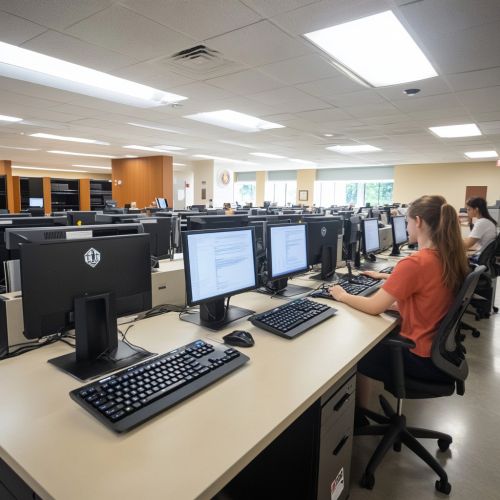GMAT: Difference between revisions
No edit summary |
No edit summary |
||
| Line 49: | Line 49: | ||
GMAC continually reviews and updates the GMAT to ensure its relevance and effectiveness. Recent developments include the introduction of the online GMAT, which allows test-takers to complete the exam remotely. Future enhancements may focus on further integrating technology and improving accessibility for a diverse range of test-takers. | GMAC continually reviews and updates the GMAT to ensure its relevance and effectiveness. Recent developments include the introduction of the online GMAT, which allows test-takers to complete the exam remotely. Future enhancements may focus on further integrating technology and improving accessibility for a diverse range of test-takers. | ||
[[Image:Detail-97927.jpg|thumb|center|Test center with computers and test-takers.]] | [[Image:Detail-97927.jpg|thumb|center|Test center with computers and test-takers.|class=only_on_mobile]] | ||
[[Image:Detail-97928.jpg|thumb|center|Test center with computers and test-takers.|class=only_on_desktop]] | |||
== See Also == | == See Also == | ||
Latest revision as of 19:59, 11 September 2024
Introduction
The Graduate Management Admission Test (GMAT) is a standardized assessment used globally to evaluate the aptitude of candidates seeking admission to graduate management programs, such as Master of Business Administration (MBA) programs. The test is designed to measure analytical writing, quantitative, verbal, and integrated reasoning skills. The GMAT is developed and administered by the Graduate Management Admission Council (GMAC).
History
The GMAT was first introduced in 1953 as a means to provide business schools with a standardized measure of applicants' potential for success in graduate management education. Over the years, the test has undergone several revisions to better align with the evolving needs of business schools and the skills required in the business world.
Test Structure
The GMAT consists of four main sections:
Analytical Writing Assessment (AWA)
The AWA section requires test-takers to analyze an argument and write a critique. This section measures the ability to think critically and communicate ideas effectively. The essay is scored on a scale of 0 to 6, in half-point increments.
Integrated Reasoning (IR)
The IR section assesses the ability to evaluate information presented in multiple formats from various sources. It includes 12 questions, which may involve graphics interpretation, two-part analysis, table analysis, and multi-source reasoning. The IR section is scored on a scale of 1 to 8, in single-digit increments.
Quantitative Section
The Quantitative section measures the ability to reason quantitatively, solve quantitative problems, and interpret graphic data. It includes 31 multiple-choice questions, divided into problem-solving and data sufficiency types. This section is scored on a scale of 0 to 60, in single-point increments.
Verbal Section
The Verbal section evaluates reading comprehension, critical reasoning, and sentence correction skills. It consists of 36 multiple-choice questions. Like the Quantitative section, it is scored on a scale of 0 to 60, in single-point increments.
Scoring and Reporting
The total GMAT score ranges from 200 to 800, combining the Quantitative and Verbal section scores. The AWA and IR scores are reported separately. Test-takers receive a preliminary score report immediately after completing the test, with the official score report available within 20 days. The score report includes percentile rankings, which indicate how a test-taker's performance compares to that of other test-takers.
Preparation and Study Resources
Preparing for the GMAT typically involves a combination of self-study, online resources, and formal preparation courses. Key resources include:
- Official GMAT study materials provided by GMAC
- Online practice tests and question banks
- GMAT preparation books from various publishers
- GMAT preparation courses, both online and in-person
Test Administration
The GMAT is administered year-round at test centers worldwide. Test-takers can register for the exam through the official GMAT website. The test is computer-adaptive, meaning the difficulty of questions adjusts based on the test-taker's performance. The test duration is approximately 3.5 hours, including optional breaks.
Importance and Impact
The GMAT is a critical component of the admissions process for many business schools. A high GMAT score can enhance an applicant's chances of admission and may also be a factor in scholarship decisions. However, it is important to note that the GMAT is just one aspect of a comprehensive application, which typically includes academic transcripts, letters of recommendation, essays, and interviews.
Criticisms and Controversies
The GMAT has faced criticism for various reasons, including:
- Potential bias against non-native English speakers
- The high cost of the test and preparation materials
- The pressure and stress associated with high-stakes testing
Despite these criticisms, the GMAT remains a widely accepted and respected measure of academic potential in the field of business education.
Future Developments
GMAC continually reviews and updates the GMAT to ensure its relevance and effectiveness. Recent developments include the introduction of the online GMAT, which allows test-takers to complete the exam remotely. Future enhancements may focus on further integrating technology and improving accessibility for a diverse range of test-takers.


See Also
References
- Graduate Management Admission Council. (n.d.). Retrieved from GMAC Official Website
- Kaplan, R. (2019). GMAT Prep Plus 2020. Kaplan Publishing.
- The Princeton Review. (2020). Cracking the GMAT. Penguin Random House.
